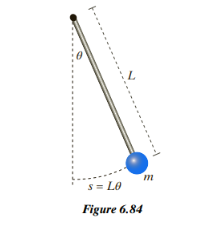A pendulum (see Figure ) consists of a very light but stiff rod of length hanging from a nearly frictionless axle, with a mass at the end of the rod.
(a) Calculate the gravitational potential energy as a function of the angle , measured from the vertical.
(b) Sketch the potential energy as a function of the angle , for angles from to .
(c) Let the arc length away from the bottom of the arc. Calculate the tangential component of the force on the mass by taking the (negative) gradient of the energy with respect to . Does your result make sense?
(d) Suppose that you hit the stationary hanging mass so it has an initial speed .
What is the minimum initial speed needed for the pendulum to go over the top ? On your sketch of the potential energy (part b), draw and label energy levels for the case in which the initial speed is less than, equal to, or greater than this critical initial speed.




